Powell and Pressburger: In Prospero's Room | reviews, news & interviews
Powell and Pressburger: In Prospero's Room
Powell and Pressburger: In Prospero's Room
A magical day at Derek Jarman’s Dungeness cottage, dancing with the ghosts of Shakespeare, Powell and Pressburger

There’s a thread of bright magic running through British cinema, from Powell and Pressburger through Nic Roeg, Derek Jarman and Lynne Ramsay, and it’s wrapped around Jarman’s last home like fisherman’s rope.
His friend and collaborator Tilda Swinton called Prospect Cottage a charged place, acting as a battery for artists. It is particularly so this weekend, as the BFI’s Powell and Pressburger season sparks the first art made here since Jarman’s death in 1994. Powell + Pressburger: In Prospero’s Room draws on an obscure but profound connection. Jarman adapted Shakespeare’s The Tempest in 1979, partly inspired by the BFI’s 1978 Powell and Pressburger season. He made fallen aristocrat-magician Prospero’s castle a place of candle-glow and deep shadow, grotesque power-plays and sexual liberation, haunted silence and camp, intensely moving MGM musical song and dance, on an island shrouded in dislocating blue fog. Poet-magician Heathcote Williams played Prospero with quiet incantatory power, with punk singer Toyah Wilcox, pictured below, as his innocently erotic daughter Miranda.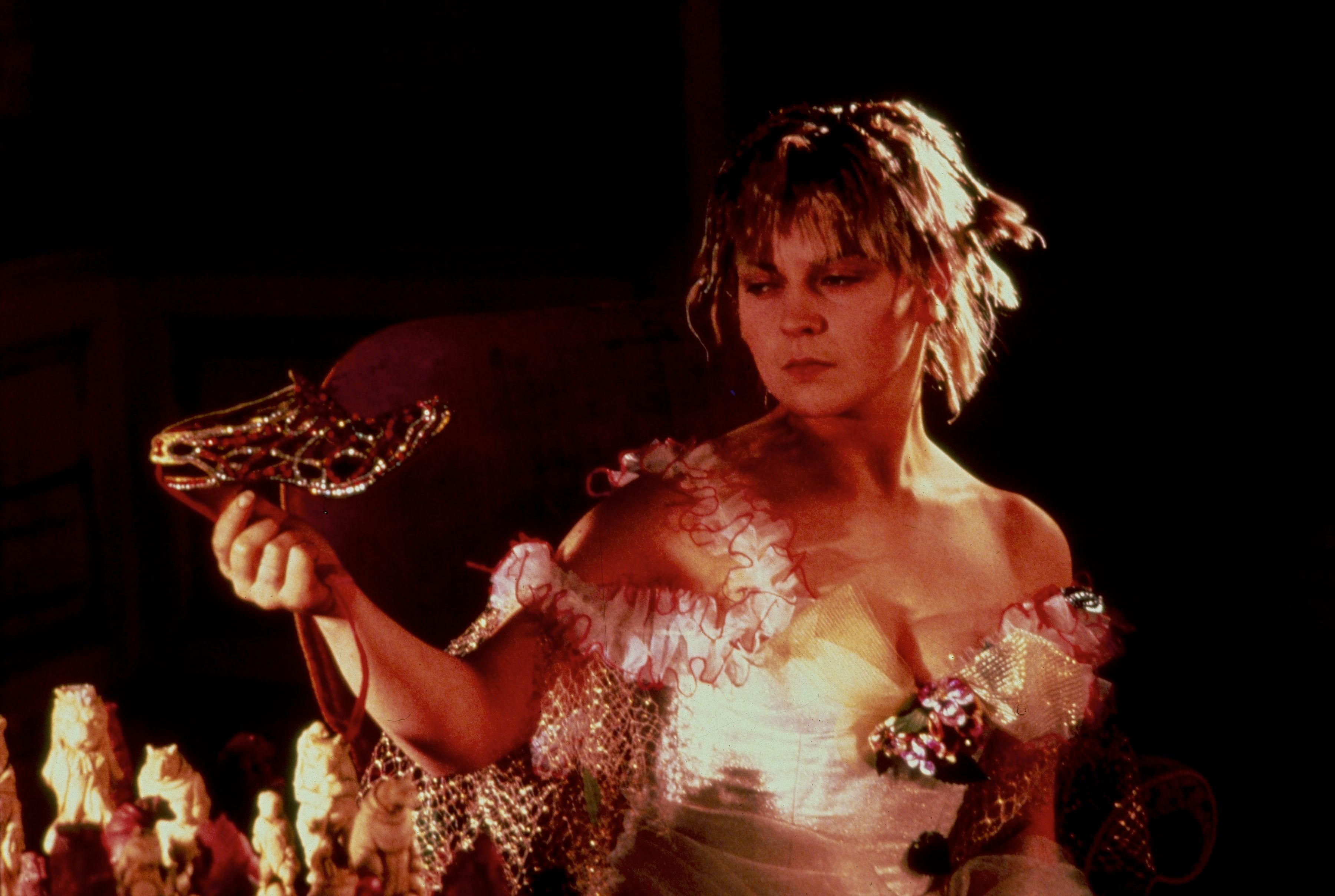 Michael Powell meanwhile tried to make his own Tempest for 15 years, with James Mason as Prospero. He said the play contained “all the things that I loved and believed in”, and came closest to filming it out of all his unrealised projects, after the scandalous Peeping Tom (1960) all but ended his career. “When I was making The Tempest… I kept saying to my producer, ‘Michael Powell should be making this – I’ve stolen it from him,’” Jarman confessed to interviewer Ian Christie. Both men shared the idea of the director as Prospero-like magus. “It’s very difficult to deal with our culture mythically,” Jarman considered to Christie, pointing to Powell and Pressburger’s The Life and Death of Colonel Blimp (1943) and A Canterbury Tale (1944) as rare exemplars, and the latter’s manipulative, tragic magistrate Thomas Colpepper (Eric Portman) – who appears satyr-like in the Kentish fields he reveres – as a Prospero-manque. In Prospero’s Room therefore scatters mementos of both men’s Tempests through Prospect Cottage, alongside film art responding to Powell and Pressburger’s rapturous visions.
Michael Powell meanwhile tried to make his own Tempest for 15 years, with James Mason as Prospero. He said the play contained “all the things that I loved and believed in”, and came closest to filming it out of all his unrealised projects, after the scandalous Peeping Tom (1960) all but ended his career. “When I was making The Tempest… I kept saying to my producer, ‘Michael Powell should be making this – I’ve stolen it from him,’” Jarman confessed to interviewer Ian Christie. Both men shared the idea of the director as Prospero-like magus. “It’s very difficult to deal with our culture mythically,” Jarman considered to Christie, pointing to Powell and Pressburger’s The Life and Death of Colonel Blimp (1943) and A Canterbury Tale (1944) as rare exemplars, and the latter’s manipulative, tragic magistrate Thomas Colpepper (Eric Portman) – who appears satyr-like in the Kentish fields he reveres – as a Prospero-manque. In Prospero’s Room therefore scatters mementos of both men’s Tempests through Prospect Cottage, alongside film art responding to Powell and Pressburger’s rapturous visions.
Prospect Cottage feels like an island as it’s approached past Dymchurch and Lydd, till all that’s left are Dungeness’s shanty-like fisherman’s cottages, exposed to the elements on the shingled beach. Flat Kent marshland and sea surround you, the grey skies and rolling waves tempestuous enough, the low horizon lined by pylons, and otherwise broken by lighthouses and a squat nuclear power station. Prospect Cottage’s timber-planked walls and tarred tin roof are black, with bright yellow window-frames. Jarman’s garden is made of rusting flotsam, stone circles and pebble-skull sculptures, like a series of spells marking his territory. He moved here in 1986 as AIDS afflicted him, and it is a house to work in with collaborators, amidst elemental nature, away from unwanted human distraction.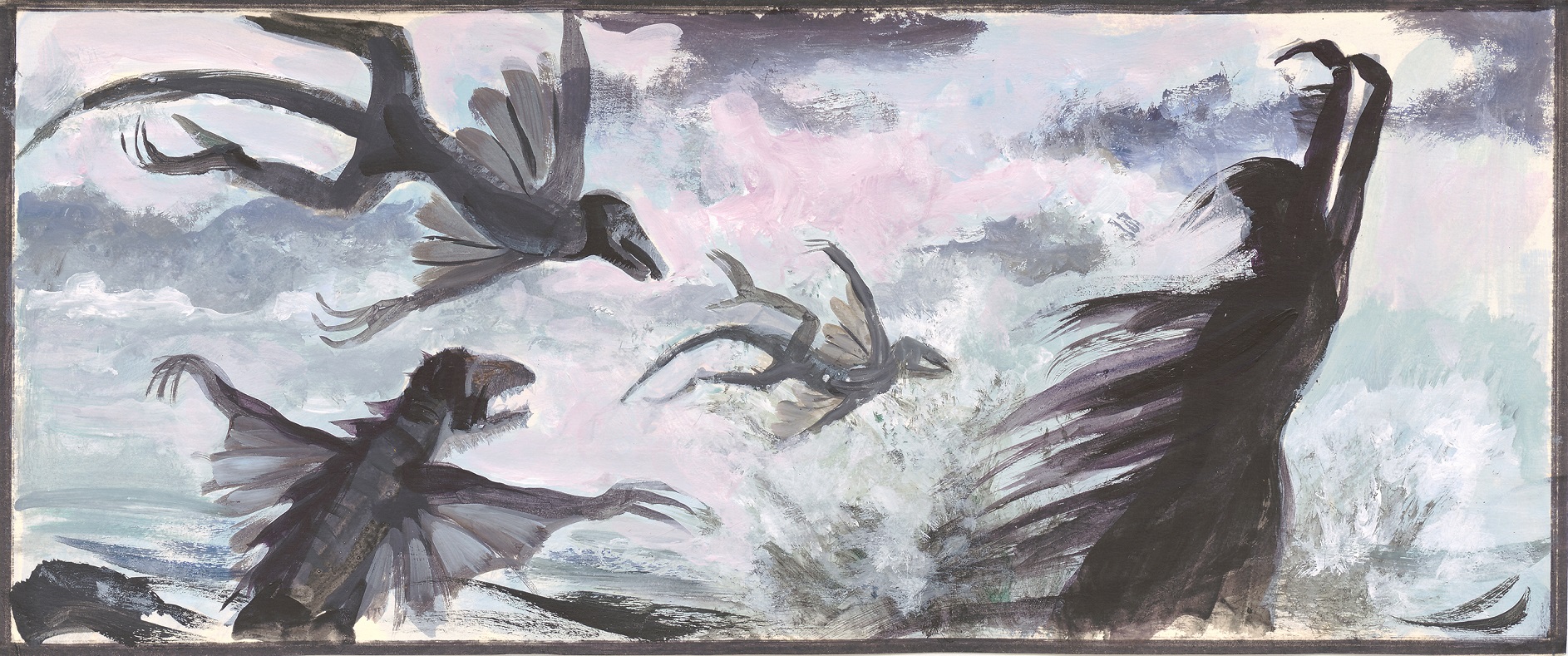 In Prospero’s Room subtly remakes four rooms. The conservatory offers Ivor Beddoes’ early Seventies production designs for Powell’s Tempest, left on the sofa as if Powell just perused them, and framed and draped along the walls. Beddoes had worked with Powell since Black Narcissus (1947), and perfectly understood his unfashionable desire for Prospero’s island to be “completely un-naturalistic… everything in a studio set or painting”, inspired by the lost, prehistoric kingdoms of Jules Verne, Conan Doyle and King Kong, and Goya and Bosch. Painted sketches show lizard-birds at the bidding of a feathery figure, surely Ariel and his creatures, pictured above. Larger, pastel paintings show Prospero’s castle as a ruined, once civilised headland off a storm-darkened mountain spine (pictured below) and, still more tantalisingly, gold-cloaked Prospero in a circle of light and outer runic ring as Ariel ascends with the sun, suggesting the risen Christ. You can see Beddoes’ rough, shaping lines beneath the paint, the hand-drawn start of unmade magic. Like Kubrick’s Napoleon, this suggested film grows in the mind. The conservatory’s extant artefacts include one of the Cottage’s many carved Christs, this one crucified on a small buzzsaw, and Jarman’s gardening gloves.
In Prospero’s Room subtly remakes four rooms. The conservatory offers Ivor Beddoes’ early Seventies production designs for Powell’s Tempest, left on the sofa as if Powell just perused them, and framed and draped along the walls. Beddoes had worked with Powell since Black Narcissus (1947), and perfectly understood his unfashionable desire for Prospero’s island to be “completely un-naturalistic… everything in a studio set or painting”, inspired by the lost, prehistoric kingdoms of Jules Verne, Conan Doyle and King Kong, and Goya and Bosch. Painted sketches show lizard-birds at the bidding of a feathery figure, surely Ariel and his creatures, pictured above. Larger, pastel paintings show Prospero’s castle as a ruined, once civilised headland off a storm-darkened mountain spine (pictured below) and, still more tantalisingly, gold-cloaked Prospero in a circle of light and outer runic ring as Ariel ascends with the sun, suggesting the risen Christ. You can see Beddoes’ rough, shaping lines beneath the paint, the hand-drawn start of unmade magic. Like Kubrick’s Napoleon, this suggested film grows in the mind. The conservatory’s extant artefacts include one of the Cottage’s many carved Christs, this one crucified on a small buzzsaw, and Jarman’s gardening gloves.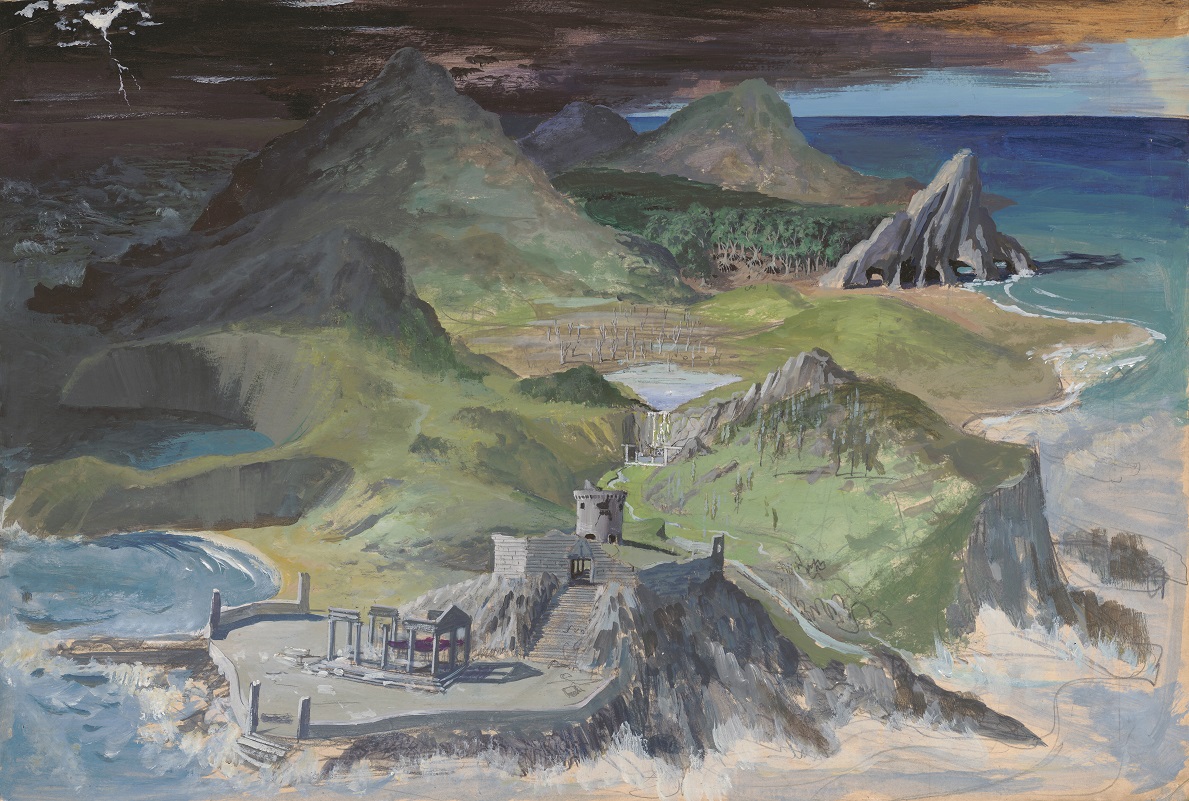 Jarman’s other rooms are wood-panelled cabins, enclosed as if at sea. In his workshop, his Tempest now plays on DVD, one of several mesmeric Jarman or Powell-derived murmurs in Prospect Cottage today. Look away, and Heathcote Williams’ silky tones as Prospero irresistibly suggest Vincent Price. Glass-panelled bookcases contain Arthur Mee’s set of county guides, The King’s England, Jarman’s collection of books on Elizabethan magus and reputed Prospero model John Dee, and dark-blue, crystal-like balls from Aleister Crowley, the self-styled Wickedest Man in the World who died down the coast in a Hastings B&B. Jarman’s Tempest production sketches are slipped inside the glass, including his Prospero profile: “Black shiny costume like Robespierre… Prospero is black and white – part earth & part magic”.
Jarman’s other rooms are wood-panelled cabins, enclosed as if at sea. In his workshop, his Tempest now plays on DVD, one of several mesmeric Jarman or Powell-derived murmurs in Prospect Cottage today. Look away, and Heathcote Williams’ silky tones as Prospero irresistibly suggest Vincent Price. Glass-panelled bookcases contain Arthur Mee’s set of county guides, The King’s England, Jarman’s collection of books on Elizabethan magus and reputed Prospero model John Dee, and dark-blue, crystal-like balls from Aleister Crowley, the self-styled Wickedest Man in the World who died down the coast in a Hastings B&B. Jarman’s Tempest production sketches are slipped inside the glass, including his Prospero profile: “Black shiny costume like Robespierre… Prospero is black and white – part earth & part magic”.
Jarman’s reproduced, hand-written Tempest thesis lies by the TV where the film plays. He means to resolve Shakespeare’s “narrative drifting… like the enigmatic music which haunts the island”, and “recapture...the mystery and atmosphere of the original work”: “a highly topical political play for an audience who believed in the reality of its magic”. “There are films where magic work,” he says, an ambition he shared with Powell and Pressburger, and notes examples: the “mesmeric alienating world” of The Cabinet of Dr Caligari, and Bergman’s The Hour of the Wolf, “in which the whole landscape is alive with apparitions and malevolent dreams”. Drawing on “Freud and particularly Jung”, he hoped to convince Seventies audiences of The Tempest’s spell. The paint-pots and spattered furniture of the cinema wizard who wrote these notes, his self-portrait and Maggi Hambling’s blue, posthumous painting of him already fill this net-curtained room, darkened by today’s wintry shadows.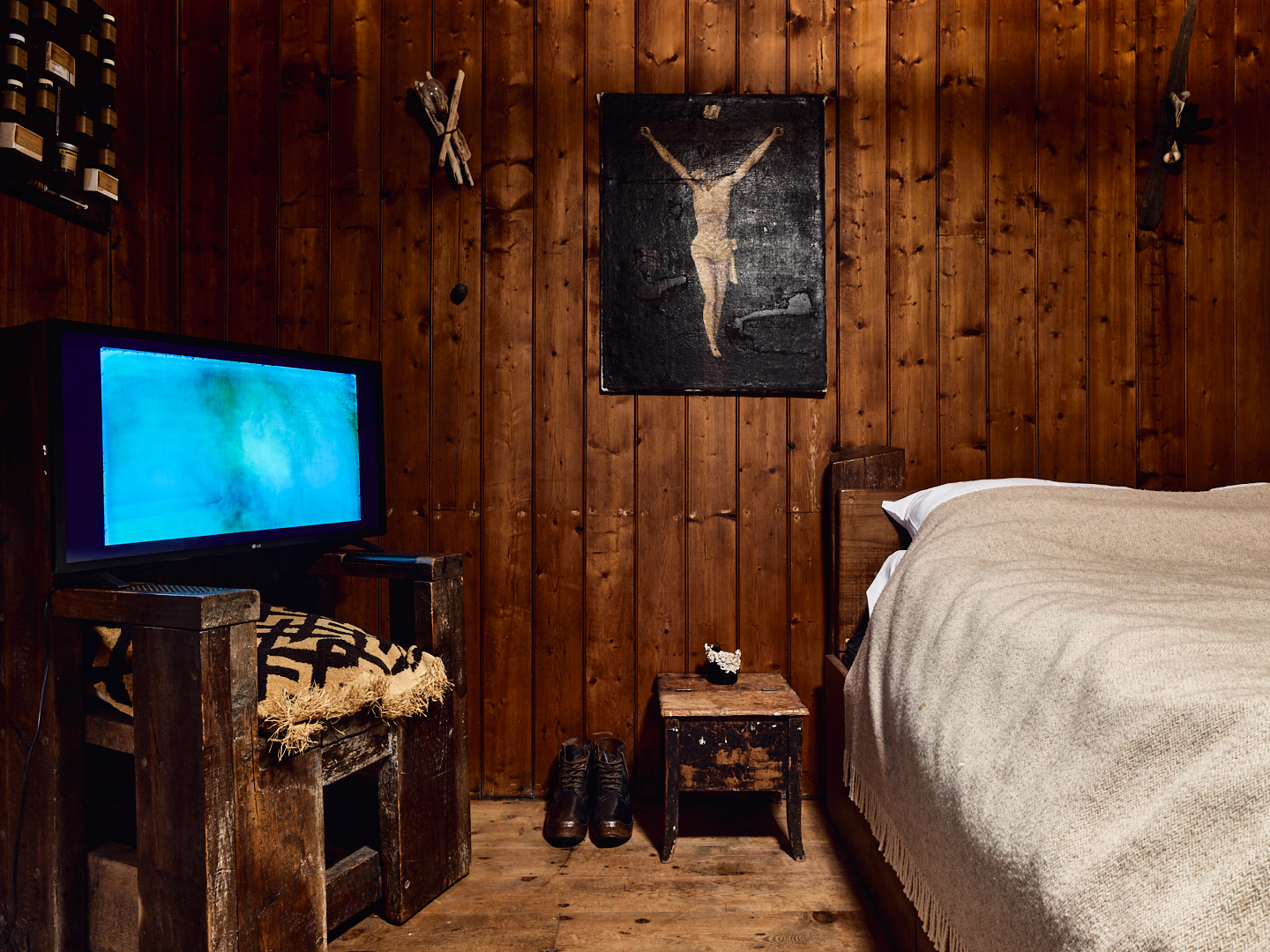 In Jarman’s bedroom across from his neatly made bed, pictured above, film artist Adebukola Bodunrin’s three-minute video Even When Life Is Sad, People Still Have a Good Time (2005) rips and dissolves Moira Shearer’s dancing in Powell and Pressburger’s The Tales of Hoffman (1951), as if the footage is being elementally assaulted by fire and water, and slashed by lightning. In the front room, Powell’s German TV adaptation of Bartók’s opera Bluebeard’s Castle (1963), a rare work from the director’s twilight, glistens with crystalline colour, its painterly artifice showing his fraternity with Jarman. In the study, pictured below, the room heaviest in atmosphere with its dark furniture and frame, words and images from weird wartime fable A Canterbury Tale are manipulated in Victor Burgin’s video Listen to Britain, made under 9/11’s war cloud.
In Jarman’s bedroom across from his neatly made bed, pictured above, film artist Adebukola Bodunrin’s three-minute video Even When Life Is Sad, People Still Have a Good Time (2005) rips and dissolves Moira Shearer’s dancing in Powell and Pressburger’s The Tales of Hoffman (1951), as if the footage is being elementally assaulted by fire and water, and slashed by lightning. In the front room, Powell’s German TV adaptation of Bartók’s opera Bluebeard’s Castle (1963), a rare work from the director’s twilight, glistens with crystalline colour, its painterly artifice showing his fraternity with Jarman. In the study, pictured below, the room heaviest in atmosphere with its dark furniture and frame, words and images from weird wartime fable A Canterbury Tale are manipulated in Victor Burgin’s video Listen to Britain, made under 9/11’s war cloud.
These artistic interventions benignly haunt and enliven Jarman’s old rooms, and invoke an intimate, living relationship with Powell, Pressburger and beyond. Stepping outside on this indifferent grey day, the landscape which cradled the gradually debilitated Jarman’s last, intensely productive eight years has an inherent English beauty.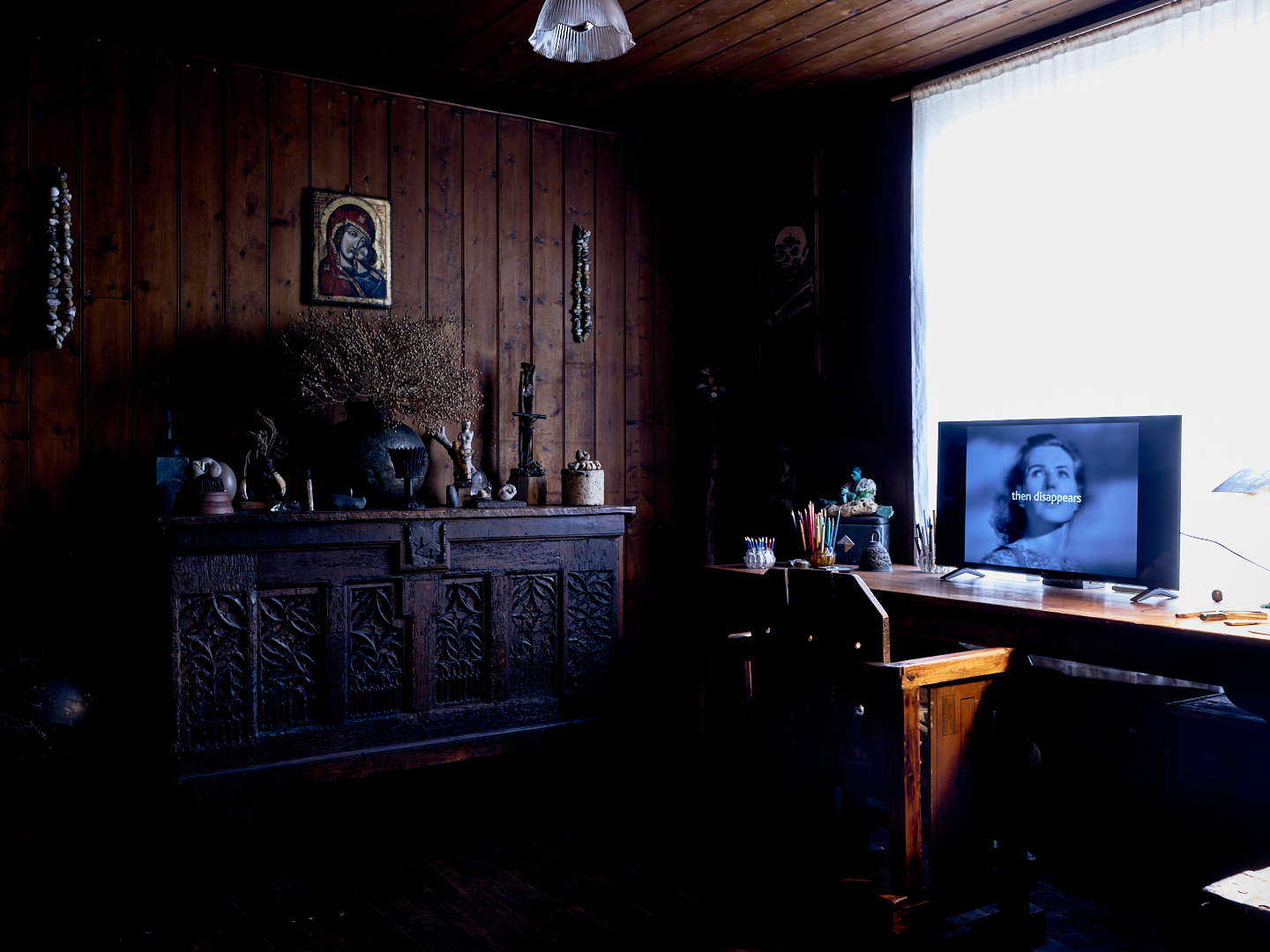 The BFI’s Powell and Pressburger celebration has one more treat on the day of my visit. In an annex of Folkestone’s Gothically dark former hotel the Grand, Jarman’s regular costume designer Sandy Powell (later a triple-Oscar-winner and Scorsese foil) is interviewed alongside another of his Eighties collaborators, set designer Simon Costin. With the softly curved line of her red hair and red ankle-boots, Powell still looks the part of a life she now recognises was indirectly influenced by Powell and Pressburger, via her teenage love of Bowie and awareness of his dance hero Lindsay Kemp, who she sought out for work in 1980. “Looking back, everything about Lindsay was The Red Shoes and The Tales of Hoffman,” she says. “He might have been dancing down the street, or dancing in a bar, but it was The Red Shoes.” With both Kemp and Jarman, “the theatricality in their work you can trace back to Powell and Pressburger… a heightened reality… I think that’s the bit that I’ve taken.”
The BFI’s Powell and Pressburger celebration has one more treat on the day of my visit. In an annex of Folkestone’s Gothically dark former hotel the Grand, Jarman’s regular costume designer Sandy Powell (later a triple-Oscar-winner and Scorsese foil) is interviewed alongside another of his Eighties collaborators, set designer Simon Costin. With the softly curved line of her red hair and red ankle-boots, Powell still looks the part of a life she now recognises was indirectly influenced by Powell and Pressburger, via her teenage love of Bowie and awareness of his dance hero Lindsay Kemp, who she sought out for work in 1980. “Looking back, everything about Lindsay was The Red Shoes and The Tales of Hoffman,” she says. “He might have been dancing down the street, or dancing in a bar, but it was The Red Shoes.” With both Kemp and Jarman, “the theatricality in their work you can trace back to Powell and Pressburger… a heightened reality… I think that’s the bit that I’ve taken.”
“It was an awareness that there’s a parallel world running alongside this one,” Costin says of Powell and Pressburger’s importance, “a magical world, just beyond the veil.” It’s Prospero again, whose boundless realm also runs through Blake and British literary inheritors including Michael Moorcock and Alan Moore, whose own last comic, The League of Extraordinary Gentlemen: The Tempest (2018-19) saw him pictured in the guise of Prospero, plotting the magical world’s conquest of oppressive, prosaic reality. The last issue of Neil Gaiman’s The Sandman, too, was titled “The Tempest”, with Shakespeare’s writing of his final play interlaced with that fantasy epic’s end.
Powell’s tales of Scorsese, Jarman and the Powell and Pressburger-indebted Neil Jordan (think of the Dubliner’s richly artificial English fantasias from The Company of Wolves to Byzantium) end with a consideration of an “extraordinary set of creative relationships” begun in Seventies and Eighties New York. It was here that Scorsese revived Michael Powell’s standing, The Red Shoes and Powell himself influenced Raging Bull, and Scorsese’s indispensable editor ever since, Thelma Schoonmaker, met and married Powell. Powell was of course a Kentish man, and on this long day in the county where he was raised and Derek Jarman found a home, their marvellous skein of English genius breathes again.
rating
Share this article
The future of Arts Journalism
You can stop theartsdesk.com closing!
We urgently need financing to survive. Our fundraising drive has thus far raised £49,000 but we need to reach £100,000 or we will be forced to close. Please contribute here: https://gofund.me/c3f6033d
And if you can forward this information to anyone who might assist, we’d be grateful.

Subscribe to theartsdesk.com
Thank you for continuing to read our work on theartsdesk.com. For unlimited access to every article in its entirety, including our archive of more than 15,000 pieces, we're asking for £5 per month or £40 per year. We feel it's a very good deal, and hope you do too.
To take a subscription now simply click here.
And if you're looking for that extra gift for a friend or family member, why not treat them to a theartsdesk.com gift subscription?
more Film
 Bugonia review - Yorgos Lanthimos on aliens, bees and conspiracy theories
Emma Stone and Jesse Plemons excel in a marvellously deranged black comedy
Bugonia review - Yorgos Lanthimos on aliens, bees and conspiracy theories
Emma Stone and Jesse Plemons excel in a marvellously deranged black comedy
 theartsdesk Q&A: director Kelly Reichardt on 'The Mastermind' and reliving the 1970s
The independent filmmaker discusses her intimate heist movie
theartsdesk Q&A: director Kelly Reichardt on 'The Mastermind' and reliving the 1970s
The independent filmmaker discusses her intimate heist movie
 Blu-ray: Wendy and Lucy
Down-and-out in rural Oregon: Kelly Reichardt's third feature packs a huge punch
Blu-ray: Wendy and Lucy
Down-and-out in rural Oregon: Kelly Reichardt's third feature packs a huge punch
 The Mastermind review - another slim but nourishing slice of Americana from Kelly Reichardt
Josh O'Connor is perfect casting as a cocky middle-class American adrift in the 1970s
The Mastermind review - another slim but nourishing slice of Americana from Kelly Reichardt
Josh O'Connor is perfect casting as a cocky middle-class American adrift in the 1970s
 Springsteen: Deliver Me From Nowhere review - the story of the Boss who isn't boss of his own head
A brooding trip on the Bruce Springsteen highway of hard knocks
Springsteen: Deliver Me From Nowhere review - the story of the Boss who isn't boss of his own head
A brooding trip on the Bruce Springsteen highway of hard knocks
 The Perfect Neighbor, Netflix review - Florida found-footage documentary is a harrowing watch
Sundance winner chronicles a death that should have been prevented
The Perfect Neighbor, Netflix review - Florida found-footage documentary is a harrowing watch
Sundance winner chronicles a death that should have been prevented
 Blu-ray: Le Quai des Brumes
Love twinkles in the gloom of Marcel Carné’s fogbound French poetic realist classic
Blu-ray: Le Quai des Brumes
Love twinkles in the gloom of Marcel Carné’s fogbound French poetic realist classic
 Frankenstein review - the Prometheus of the charnel house
Guillermo del Toro is fitfully inspired, but often lost in long-held ambitions
Frankenstein review - the Prometheus of the charnel house
Guillermo del Toro is fitfully inspired, but often lost in long-held ambitions
 London Film Festival 2025 - a Korean masterclass in black comedy and a Camus classic effectively realised
New films from Park Chan-wook, Gianfranco Rosi, François Ozon, Ildikó Enyedi and more
London Film Festival 2025 - a Korean masterclass in black comedy and a Camus classic effectively realised
New films from Park Chan-wook, Gianfranco Rosi, François Ozon, Ildikó Enyedi and more
 After the Hunt review - muddled #MeToo provocation
Julia Roberts excels despite misfiring drama
After the Hunt review - muddled #MeToo provocation
Julia Roberts excels despite misfiring drama
 London Film Festival 2025 - Bradley Cooper channels John Bishop, the Boss goes to Nebraska, and a French pandemic
... not to mention Kristen Stewart's directing debut and a punchy prison drama
London Film Festival 2025 - Bradley Cooper channels John Bishop, the Boss goes to Nebraska, and a French pandemic
... not to mention Kristen Stewart's directing debut and a punchy prison drama
 Ballad of a Small Player review - Colin Farrell's all in as a gambler down on his luck
Conclave director Edward Berger swaps the Vatican for Asia's sin city
Ballad of a Small Player review - Colin Farrell's all in as a gambler down on his luck
Conclave director Edward Berger swaps the Vatican for Asia's sin city

Add comment